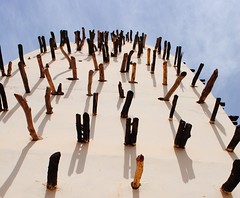Soon after we had cautiously loaded our bikes onto a coach in Essaouira, our stomachs were put to the test on windy moutainous roads leading to Agadir. But this mild discomfort pales compared to the exhaustion we would have felt had we cycled.
Our original plan was to spend one night in Tan-Tan in order to get right back onto the road following a few days off. But as soon as we met Mustapha, who we found on couchsurfing; we knew we would have to prolong our stay. By the time we’d unloaded our bikes and panniers, we’d already been introduced to his
brother, Nourdinne, and soon we were sipping tea with his mother, another brother; cousin, sister and brother-in-law.
‘Here we say that when we have a guest, our house becomes his house and we become the guests’, says Rachid, the youngest of the brothers.
 After dinner, the conversation turns towards the British love of animals. Before we knew it, we were receiving animal deliveries; a couple of tortoises, a rabbit and a puppy plucked from the street.
After dinner, the conversation turns towards the British love of animals. Before we knew it, we were receiving animal deliveries; a couple of tortoises, a rabbit and a puppy plucked from the street.
The following day was a treat for the senses: we spent most of the morning in Mustapha’s spice shop, looking at the herbs, spices, oils, remedies and soaps, trying to think of cunning ways of carrying them on the bikes and failing.
In the afternoon Rachid invited us to visit the Hamam. Excited at the prospect of a good scrub we were quick to accept the invitation.
Rachid, sesitive to the fact that I would have no way of communicating with the women who work in the Hamam (men and women naturally have seperate rooms), spoke with them beforehand to explain that a European would need babysitting.
Taken by the hand a plump Moroccan woman undressed me in the business fashion of a stressed mother. Leading me to the hottest room of three the exfoliation began. Using traditional soaps that Mustapha provided from his shop she scrubed my skin to a shade of raw pink.
Occassionaly she raised her head and showed me the rough mit, originally black it now accepted the colour of the first layer of my skin, she would tut dissaprovingly of my lazy exfoliation habits and then continue at the hard grind.
Whilst a little tough on the skin the experience was actually rather wonderful. I think I had made the false assumption that women lacked social time in Morocco. Its very easy to see men in the streets sipping tea and chatting all day, this brought both Imran and I to feel that women were somehow deprived of this of time.
There is, however, something rather sweet in being proved wrong. Seeing the women of the Hamam working together and bathing in the same rooms with no inhibitions brought me to realise how intimate the friendships between women are here. I felt a sense of a sisterhood as I was roughly undressed. Feeling rather exposed and a little sheepish I wished for a moment I had not accepted the Hamam invitation, but just then, as I felt so shy and out of place, the young woman next to me had spoken softly and with a smile said simply,
‘Bienvenue au Maroc’.






